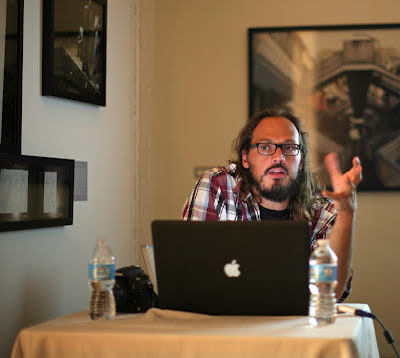If something is Self Contained it is said to be complete in itself; fully independent. Someone who is self contained is thought of as being reserved and in control. We may or may not equate self containment with self contentment. Perhaps a very thin line exists between self containment and self confinement. Just some things to consider. I am open to a wide range of explorations on this theme. Release that inner formality and self control. Breathe deep. Scream loudly. Show me what this theme is all about.
It is with great pleasure that I present a selection of images submitted in response to this call for work. Two hundred and fifty photographers from around the world submitted just under seven hundred photographs. The exhibit you will see consists of sixty five images by forty six photographers. It goes without saying that choosing images from a large submission pool means agonizing over final choices. Too many highly talented photographers, and exceptional images, get left on the cutting room floor and that is the biggest downside to curating a project such as this. I am looking forward to featuring some of the photographers whose work was not chosen for this exhibit in future posts on
PHOTO/arts Magazine.
 |
| Martin Buday My Own Wilderness (2011) |
While
Self Contained is a stand alone exhibit, it is also directly related to last year's exhibition,
My Own Wilderness.
(In fact, four photographers return from My Own Wilderness; Ellen Jantzen, Laura Glabman, Andi Schreiber, and Irina Volgareva.) A familiarity with the images in
My Own Wilderness will enhance the experience of viewing
Self Contained. A study of both exhibits will reveal a subtle conversation taking place among global artists.
My Own Wilderness was primarily about personal space/place, while
Self Contained is a study in personal identity. Both themes are ripe for emotion and psychology. The participating photographers do not disappoint in that regard. So many of the artists you will encounter here have reached down deeply to reveal what is raw and often difficult to express photographically. I can only hope that my editing choices and sequencing of images will improve the readability of these fascinating emotional stories.
 |
| Dan Talley Self Contained (2012) |
I also hope you will enjoy the format for this exhibit. I have tried something a bit different from last year. It was my opinion that the video format used last year, while beautiful, was not something that viewers could easily return to again and again. At fifteen minutes in length, it required too much time for a casual visit. The idea behind this format is a more interactive experience. Something you can look at and refer to any time. Please let me know what you think.
In addition to the exhibition of forty six images that will also be published in the upcoming book, this format allows me to showcase the full submissions from the selected winners, as well as their artist statements. Please join me in congratulating the three winners and two honorable mentions-
First Place
($200 Gift Certificate) Louis Michael Hernandez Rochester, NY
Second Place
($100 Gift Certificate) Emily Franklin Dekalb, Illinois
Third Place
($50 Gift Certificate) Aaron Hobson Adirondack Mountains, USA
Honorable Mention
Viacheslav Kabanov Moscow, Russia
Honorable Mention
Andi Schreiber Scarsdale, NY
Thanks once again to all who participated in this call for work. It was an honor to experience such talented and thoughtful expression of art. Please enjoy the final results, and I welcome any feedback or comments.
Self Contained Online











.jpg)



























